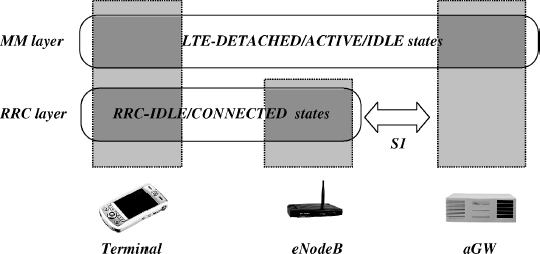5.2 Communication Sessions
5.2.1 Terminal States
When presenting the evolved UMTS requirements, we briefly introduced the notion of ‘terminal state’. In circuit applications, only two states are really useful (‘connected’ and ‘disconnected’), reflecting the actual service state. However, when considering the various ranges of packet applications, intermediate states may have some interest, e.g. in phases where the session is set up but not active for a certain period of time. Such states would allow the network (including the Access Network and also the Evolved Packet Core) to manage resources in a more efficient way. This kind of flexibility cannot be provided by circuit-switched applications, as ‘connected’ implies guaranteed service capabilities in terms of bit rate and transfer delay.
For that purpose, two terminal state machines have been introduced within the standard, both maintained by the terminal and the network (Figure 5.8). The first machine is located at the RRC layer and maintained in the network by the eNodeB; the other is placed at the MM level and maintained in the network at the aGW level within the Packet Core.

Figure 5.8 RRC and MM state machines.

Figure 5.9 Evolved UMTS Terminal states and transitions.
(i) The Evolved UMTS Terminal States
The MM and RRC levels ...
Get Evolved Packet System (EPS): The LTE and SAE Evolution of 3G UMTS now with the O’Reilly learning platform.
O’Reilly members experience books, live events, courses curated by job role, and more from O’Reilly and nearly 200 top publishers.

